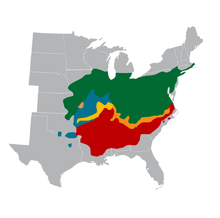Magicicada neotredecim
| Magicicada neotredecim | |
|---|---|
 | |
| Scientific classification | |
| Kingdom: | Animalia |
| Phylum: | Arthropoda |
| Class: | Insecta |
| Order: | Hemiptera |
| Family: | Cicadidae |
| Genus: | Magicicada |
| Species: | M. neotredecim |
| Binomial name | |
| Magicicada neotredecim Marshall & Cooley, 2000 | |
Magicicada neotredecim is the most recently discovered species of periodical cicada. Like all Magicicada species, M. neotredecim has reddish eyes and wing veins and a black dorsal thorax.[1] It has a 13-year life cycle but seems to be most closely related to the 17-year species Magicicada septendecim. Both species are distinguished by broad orange stripes on the abdomen and a unique high-pitched song said to resemble someone calling "weeeee-whoa" or "Pharaoh." They differ only in life cycle length.[2]
Another closely related 13-year species Magicicada tredecim differs very slightly from M. neotredecim, and for many years the two were considered one species with slight differences in abdomen color and mitochondrial DNA. Then in 1998, scientists studying the calls of Brood XIX distinguished two different peak frequencies in the -decim species call.[2][3] Because of their many similarities, M. neotredecim, M. tredecim, and M. septendecim are often described together as "decim periodical cicadas."
Broods and distribution
Periodical cicadas are assigned to broods based on their year of emergence and life-cycle length. The other three 13-year species (M. tredecim, M. tredecassini, and M. tredecula) are represented in all three of the extant 13-year broods: Brood XIX (emerging in 2011), Brood XXII (emerging in 2014), and Brood XXIII (emerging in 2015). M. neotredecim was first discovered in 1998 in Brood XIX, where it occurs toward the northern part of the range, showing a narrow range of overlap with the more southern species M. tredecim. It has also been observed in Brood XXIII but not in Brood XXII.[2]

Discovery in 1998
Magicicada males typically form large aggregations that sing in chorus to attract receptive females.[2] M. neotredecim was first identified when scientists noticed a bimodal split in the dominant pitch (frequency) of male calling songs during the 1998 emergence of Brood XIX. The dominant song pitch of M. neotredecim ranges from 1.25 kHz to 1.90 kHz. (This is similar to the pitch-range of M. septendecim except that songs of the 17-year species do not extend so far into high frequencies.) M. neotredecim song frequencies have been observed to displace upward in areas where their range overlaps with the similar M. tredecim, whose dominant song pitch is lower, ranging between 1.00 kHz and 1.25 kHz.[4][5]
These distinctive calling songs prompted a closer look at older data concerning M. tredecim. Two different forms of mitochondrial DNA, correlated with a difference in abdominal color, had already been seen in insects assigned to this species. David Marshall and John Cooley determined that these known differences correlated with the observed pitch difference in males and a corresponding pitch preference in females. The name M. neotredecim was given to the variant whose song and abdominal coloring (orange with a black lateral band or center) resemble the 17-year species M. septendecim. The earlier name M. tredecim was reserved for the group whose abdomen is mostly orange and whose song has a lower pitch.[5]
References
- ↑ Alexander, Richard D.; Thomas E. Moore (1962). "The Evolutionary Relationships of 17-Year and 13-Year Cicadas, and Three New Species (Homoptera, Cicadidae, Magicicada)" (PDF). University of Michigan Museum of Zoology. Retrieved 9 June 2011.
- 1 2 3 4 "Periodical Cicada Page". University of Michigan. Retrieved 10 June 2011.
- ↑ "Magicicada neotredecim Marshall and Cooley 2000". National Geographic Society. Retrieved 10 June 2011.
- ↑ "Digital song recording for holotype male of Magicicada neotredecim Marshall and Cooley". Connecticut Entomological Society. Retrieved 11 June 2011.
- 1 2 Marshall, David C.; John R. Cooley (2000). "Reproductive character displacement and speciation in periodical cicadas, and a new 13- year species, Magicicada neotredecim." (PDF). Evolution. 54 (4): 1313–1325. doi:10.1111/j.0014-3820.2000.tb00564.x. PMID 11005298. Retrieved 11 June 2011.